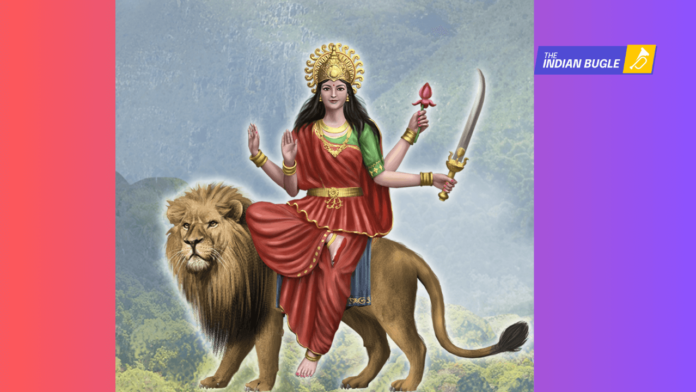Day Six of Navratri honors Maa Katyayani, the warrior-mother form of Durga. Fierce yet compassionate, Katyayani embodies courage, protection, and the power to destroy evil. Worshipping her on the sixth day removes obstacles, grants strength to face life’s challenges, and blesses devotees with discipline, confidence, and victory. Maa Katyayani is more commonly known as Maa Mahishasura Mardini.
Who is Maa Katyayani? (Appearance & Mythic Significance)
Maa Katyayani is usually depicted as a young, radiant warrior goddess riding a lion, with four hands holding a sword, lotus, and other weapons — symbols of wisdom, purity, and strength. She is often shown with a fierce yet compassionate expression: ready to protect the innocent and destroy negative forces.
Mythologically, she is connected with sage Katyayana’s penance: as a result of deep tapasya, Parvati manifested as Katyayani to defeat the demons troubling the heavens and earth. She is also worshipped by those seeking success in difficult endeavors and protection from nastier influences.
Symbolism — what to focus on during worship
- Lion (vahana): Fearlessness, mastery of animal instincts.
- Weapons (sword, trident): Cutting through ignorance and ego.
- Lotus: Purity, spiritual awakening even amid life’s dust.
- Red color & flowers: Energy, vigor, and the active shakti (power).
Preparations — what you’ll need (puja samagri checklist)
- A clean altar space, red/orange cloth to cover the altar.
- Picture or murti (idol) of Maa Katyayani (or a general Durga image).
- Kalash (optional) for Navratri continuity, lamp (diya), incense (agarbatti).
- Red flowers (hibiscus, rose, marigold), preferably freshly plucked.
- Red vermilion (sindoor/kumkum), haldi (turmeric), chandan (sandal paste).
- Fresh fruits, seasonal offerings, coconut, betel leaves (paan), and nuts.
- Sweets: ladoo, kheer, halwa, pedas, or any preferred naivedya.
- Panchamrit (milk, curd, ghee, honey, sugar) if you do abhishek or offering.
- Rice grains (akshat), diya and ghee, camphor for aarti.
- Bell (ghanta), small conch (optional), incense holder, tray for offerings.
- Red cloth or chunri to offer to the deity.
- A copy of the Katyayani stotra/mantra or printed sheet for recitation.
Best time to worship
Morning hours are traditionally preferred for invoking the goddess (Brahma muhurta to mid-morning). You may also perform a short evening ritual if mornings aren’t possible. If you follow Navratri vrata strictly, early morning puja followed by aarti is ideal.
Puja Vidhi — Step-by-step ritual for Day 6 (Katyayani)
Bath, wear clean clothes (red/orange preferred). Clean the altar and arrange the picture/murti and samagri.
If doing Navratri ghatasthapana on day 1, today continue worship; otherwise, take a short sankalp — state your intention aloud: your name, place, purpose of vrat or puja, and request the goddess’s blessings.
Offer flowers, light a lamp, and chant a short Ganesh mantra to remove obstacles.
Take water for symbolic purification and a few calming breaths to center the mind.
Invite Maa Katyayani to the altar with a short invocation: offer sandal, incense, and flowers. Place a red chunri on the image or murti.
Present fruit, coconut, sweets, and Panchamrit. Place a small plate with red flowers and akshat before the image.
Chant the Katyayani mantra or recite a stotra (see suggested mantras below). Typically chant in multiples of 9 or 108 for potency.
Perform aarti with a ghee diya; ring the bell and sing or play bhajans dedicated to Durga/Katyayani.
Sit for a few minutes in silence, meditate on the goddess’s form, and offer personal prayers.
Conclude by offering prasad to the family and guests. Share food and blessings.
Many devotees feed the needy or donate red cloth/flowers to a temple as part of the day’s merit.
Mantras & Chants (simple, effective, and respectful)
Use short, reverent chants — repeat in counts of 9, 27 or 108 depending on time and devotion.
- Simple bija/mantra (popular):
Om Aim Hreem Kleem Chamundaye Vichche
(Short, powerful; often used for the fierce forms of the Goddess.) - Katyayani short mantra:
Om Katyayanyai Namah
(8–108 repetitions are commonly used.) - Devotional shloka (for offering respect):
Ya devi sarvabhuteshu … (the “Ya Devi” stanza — a concise hymn invoking the goddess in all forms) — you may recite it as part of the stotra section.
(When chanting, keep pronunciation steady and focused. If you aren’t sure of exact Sanskrit intonation, recite slowly or use transliteration to maintain reverence.)
Special rituals & community practices
- Kumari pujan (worship of young girls): In many regions, young unmarried girls are worshipped as embodiments of the goddess and offered prasadam.
- Bhajan & kirtan nights: Singing and community aartis in the evening strengthen devotion and social bonding.
- Temple processions: In some places, the day includes processions of the goddess with music and dance.
Spiritual benefits & prayers to seek
Worshipping Maa Katyayani on Day 6 is traditionally believed to:
- Grant courage and inner strength.
- Remove fear and protect devotees from harm.
- Help those seeking success in challenging pursuits (exams, court cases, ventures).
- Bless young women seeking a good life partner (in certain folk practices Katyayani is invoked for marital blessings).
Practical tips for first-time Vratis
- Keep the ceremony simple and sincere rather than elaborate. Devotion matters more than perfection.
- Use a small bell and chant slowly; focus on breath and intention.
- If short on time, perform a brief invocation, 9–27 repetitions of the mantra, a short aarti, and offer prasad.
- If you don’t have a Katyayani image, worship a simple red-swathed Durga picture or a symbolic kalash with red flowers.
Day Six — Katyayani Puja — is a powerful moment in Navratri: an invitation to awaken inner courage, to cut through fear, and to step forward with purpose. Whether you perform an elaborate ritual or a quiet, heartfelt invocation, the essence remains the same: sincere devotion that transforms the heart.
